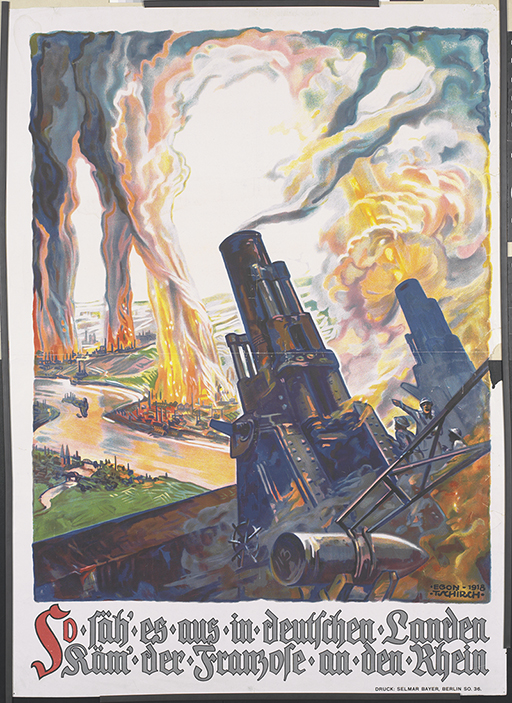3.2 German propaganda – Example 2
The second example is another German propaganda poster: ‘This is how it would look in German lands if the French reached the Rhine’ (1918).
Activity 6 Primary source analysis
You have the option to consider each question yourself before revealing our specimen answers or use our worked example for students’ skills development.
Who?
Answer
This is a German propaganda poster. The exact organisation responsible for the poster is not clear from the image itself, but we can see the artist’s name, Egon Tschirch, printed in the bottom right corner.
When?
Answer
The image is dated 1918. Though the month is unclear, this poster appears to have been made during the final months of the war, after the German army had been forced back by the Allies and a French invasion of Germany was a distinct possibility. At the same time, order was breaking down on the German home front and support for the war effort was beginning to wane.
What?
Answer
The poster depicts large artillery guns firing shells towards German territory, which is engulfed by flames and huge plumes of smoke. The River Rhine, which runs close to the French border, and through a major industrial area, is depicted flowing through the centre of the scene. The poster claims that these scenes will result if the French army continues its advance.
Purpose
Answer
By warning of the consequences of a French invasion and its potential threat to German territory, this poster persuades both soldiers and civilians to continue to support the war effort. This is likely to have been an effort to counter waning military and civilian morale.
How?
Answer
Like many examples of propaganda, the poster plays on the potential fears of its audience. The dramatic scenes of German territory being destroyed by the enemy were clearly intended to shock. Enemy troops had not entered German territory during the war, so the likelihood of this would have been a very sobering message. The short, simple message – coupled with the devastating imagery – warns against inaction in the face of the enemy.
Uses for historians
Answer
The poster reflects how German propagandists sought to maintain morale during the latter stages of the war. It demonstrates how the very real threat of enemy invasion could be used to persuade the population to stand firm. Nevertheless, as with all examples of propaganda, this poster alone cannot tell us how people responded to it. We do know, however, that continued military setbacks, coupled with waning civilian morale and revolution on the home front, eventually led to Germany’s defeat. In this sense, it could be argued that propaganda like this was ultimately unsuccessful.
In the next section you’ll find some useful resources for studying German propaganda in the First World War.

